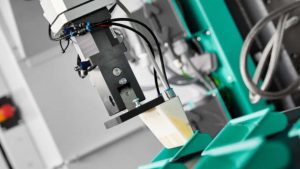Thermoplastic injection molding is a process used in manufacturing to create a variety of parts and components for industries ranging from aerospace to automotive to construction. Thermoplastics, such as phenolic and epoxy, are heated into a molten resin and then injected into a mold that’s usually made from aluminum, steel or a metal alloy. The molten plastic then gets compressed inside the mold and allowed to cool. Machines remove the plastic component or piece from the mold, and this hardened part can then be used to construct a larger product, such as a child’s toy or an automobile door.
The thermoplastic injection molding industry churns out literally thousands of products and supports hundreds of industries. As of the 1990s, nearly 20,000 different types of thermosetting and thermoplastic materials were used for injection molding. Industrialists commonly use dyes and other agents to alter the properties of the molten plastic resin, such as its color, hardness, and springiness. The molds used to shape the molten plastic generally must be precut in a separate process, using sophisticated tooling procedures to properly prepare them. A device called a sprue allows the molten resin to enter the mold and fill up the cavity. Molds also are typically designed to allow air bubbles to escape. Otherwise, during compression and heating, the air bubbles might deform the plastic and even create internal burning of the finished components.
Pre-hardened steel molds tend to be more expensive but may be longer lasting; thus, manufacturers often use these harder, higher-quality steel molds for high-volume thermoplastic injection molding jobs. For more boutique industrial work, manufacturers may use aluminum molds, which can be more cost effective for scaled-down operations. To tool molds for industrial plastic injection work, manufacturers typically employ one of two time-tested processes: electrical discharge or standard machining. With the electrical discharge process, a robot applies a voltage from a tool to alter the shape of the base metal. With standard machining, a more conventional process, a machine or tool physically warps the mold into its final shape.
Read more: What is Thermoplastic Injection Molding?

